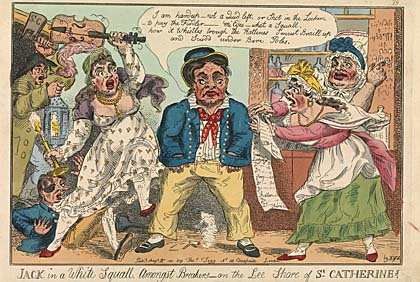
Blackwall viaduct, 1843
In late June 1850 Lady Lennard was travelling with her steward, Mr Parrott, on a London omnibus towards The Blackwall Railway. They had picked this ‘bus in particular because it advertised the railway as its destination. This was made quite clear, they thought, because the words ‘Blackwall Railway’ were ‘conspicuously painted on a board in the form of a board immediately over the door’ of the vehicle.
Mr Parrott had handed the conductor Lady Lennard’s bags and he had deposited them in a storage area and set off. However, when the ‘bus reached Fenchurch Street and the end of Railway Place, it stopped. The conductor told the pair that ‘he did not go any further’.
Now Fenchchurch Street is not remotely close to where the Blackwall Railway station (on the Docklands Light Railway line) is today, nor was it in 1850. In fact it was just over 3 miles from the Fenchurch Street terminus of the London and Blackwall Railway. The conductor presumably believed that the omnibus’ sign was self explanatory; they transported passengers to Fenchurch Street (which served the London and Blackwall railway) , but Lady Lennard’s train went from Blackwall Station, close by the River Thames, so she wasn’t happy.
With bags to carry and being and three miles from her destination, Lady Lennard was not inclined to pay for her ride, and so refused. The conductor promptly seized her luggage and said he would not return it without his fare, throwing them ‘down with violence’, onto the pavement. Mrs Lennard strode off towards the station, with her lady’s maid in two.
Meanwhile Mr Parrott tried to reason with the driver, to little effect. He was met with a mouthful of invective which attracted the attention of a police constable. He hurried after Lady Lennard and advised her to pay the fare, retrieve her luggage and then summons the conductor for his poor behaviour.
As a result the whole sorry affair ended up before the alderman magistrate at the Guildhall Police who took a very dim view of the conductor’s attitude.
In his defence the conductor, who was not named in court, said ‘he was not bound to take luggage, but having done so, it to it to the station’. He had gone to the station and and onto railway property, if the lady was unhappy she should take it up with his master, he was simply obeying his instructions.
The magistrate was unimpressed. He didn’t accept the conductor’s argument that he wasn’t obliged to carry luggage. If that was the case then he shouldn’t have accepted it, or crazed an extra fee for it. Nor was he in agreement that ‘going on to railway property was the same as going to the railway, as the direction on the omnibus indicated’.
There were two offences here, he added, both liable under the relevant act of parliament. He was minded to make an example for he conductor and fined him the large sum of 40s, 20 for each offence, plus costs. If the conductor chose not to, or was unable to pay then he could instead go to prison for two months.
[from The Morning Chronicle, Monday, June 30, 1851]







